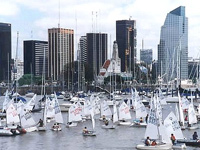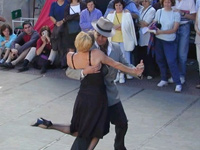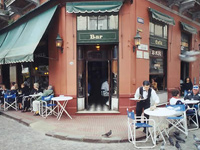At
the intersection of the Atlantic Ocean and the Rio
de la Plata - the "river of silver" that
is the world's widest river and separates Argentina
from Uruguay - lies Buenos Aires, Argentina's energetic
and captivating capital.
 |
The surprise of Buenos Aires, which literarily translates
to "good air," is that with its population
mostly of European ancestry, this city of 11 million
inhabitants, with clear exception to geography, hardly
seems what you would imagine South
America to be. There's a great mix of people living
here - German, Spanish, Italian, British, and Portuguese
- which gives it a broad European heritage.
Another surprise is that the city, for all its population,
is remarkably clean. There is virtually no trash on
the streets, and the air smells faintly of green grass
and sea spray. Even the endless skyline of tall buildings
and high rises is neatly hewn against the azure sky.
There are other things to know. For instance, there
is no such thing as "in a hurry" in Buenos
Aires, so dinner often comes late in the evening.
Time is not measured by a clock, but by a feeling,
so that means you might eat at eight or ten or even
midnight.
Buenos Aires is quite passionate and celebratory and
loves a party, so most bars and cafés are open
until dawn. The eclectic nightlife is one reason that
tourists are drawn here, but they also come for shopping,
restaurants, theater, and to learn about Argentina's
beloved icons: Evita Peron, Carlos Gardel, and Diego
Maradona.
Evita's glamorous caricature is hard to escape, as
the ghost of the former first lady hovers over the
city, simply refusing to go away. Even more than fifty
years after her death, she still pulls in tourists
as if she were alive and well. City guide Mario Ortigoza
explains her popularity, "Thanks to the movie
'Evita' and the play, she became a myth. People want
to see where and how she lived."
The arguments between those who loved her and those
who reviled her are often the fodder for entire dinner
conversations, but her beauty and prowess remain legendary,
so much so that it's easy to find a club or stage
with an Evita impersonator, complete with glittering
ball gown and a repertoire of songs including "Don't
Cry for Me, Argentina."
Buenos Aires pops and sizzles with the bold, electric pulse of tango, a dance as popular here as the two-step is in Texas, thanks in part because of Gardel, a dashingly handsome singer who, intones Ortigoza, "put lyrics into tango music and made the tango popular worldwide." The tango, defined by dramatic undertones, is immensely popular with locals and tourists alike, with trendy "tanguerias," clubs offering dinner, performances, and live music.
Diego Maradona is hailed as the one of the best Argentine sports-men of all time. Soccer, already a staple on the Buenos Aires sports scene, became even more appealing thanks to Maradona's international allure.
 |
There are other sites to see in Buenos Aires, with the heartbeat of the city being Avenida 9 de Julio or the "9th of July." Named for the date in 1816 when Buenos Aires proclaimed its independence from Spain, it is considered one of the widest boulevards in the world. From there, the tree-lined and brick-laid mosaic of avenues and sidewalks lead to sassy, sexy, and noisy "barrios" or neighborhoods, where everyone is contagiously friendly and laughter comes as easily as the beat of Latin drums.
The sequence of neighborhoods begins with Monserrat, the center of the city's political history that is located just west of the harbor. Laid out in an impressive façade of squares, buildings, ministries, and churches, including the pigeon-filled Plaza de Mayo, Monserrat is still the center for political demonstrations.
The Retiro y San Nicolas neighborhood is home to historical monuments like the 30-story Kavanagh building, built in 1935 as the city's first skyscraper. And Florida Street, an area virtually swarming with street performers and musicians, is popular among the tourists, especially for its intoxicating blend of glittering boutiques and shops. Highlighting the Retiro is the Obelisk, the most important monument in all of Buenos Aires because of its symbolism to independence.
La Boca, which literally means "the mouth," is a picturesque neighborhood that has lots of cobbled avenues, including Caminito Street, a bustling, bouncy street that has been converted into a footpath where local artisans sell their wares among the vibrantly colored tenements.
No matter which neighborhood you shop, the exchange rate of the American dollar is at a premium in Buenos Aires, so that means absolutely the best shopping in the world, especially for leather goods. From Versace, Armani and Gucci shops of Alvear Avenue to the glitzy boutiques of Florida Street and scruffy side-street flea markets, Buenos Aires says one thing: bargains, bargains, bargains.
"I was able to decorate my entire apartment in leather furniture," boasts one young man from New York. Then he paused for effect before he went on with a clever smile, "For a few hundred dollars!"
 |
Argentina reputedly produces the most flavorful and tender steaks in the world. Herds of cattle, tended by the Argentine "gauchos," graze the rich and grassy plains of the Pampas, and then the meat makes its way to nearly two thousand steakhouses, cafés, coffee houses, and bistros dotting the city, where you can also sample traditional empanadas - small stuffed pastries - "pizza a la piedra," a sort of brittle pizza, or a glass of fine local wine.
Lodging in Buenos Aires is also extremely affordable, so you can indulge in a sophisticated and sleek hotel like the Four Seasons, where Madonna stayed during the filming of "Evita." The high-end luxury hotels are always running terrific specials, so all you have to do is ask.
One more thing: The seasons are completely opposite of North America's, so when it's summer in the U.S., Argentines are enjoying mild winters. In any season, Buenos Aires is a great walking city, but it also has a vast public transportation system of trains, subways, taxis, and buses.
There is a world of possibilities in Buenos Aires, and the city, glistening and warm under a perennially sun-soaked sky, is starving to be explored.
If You Go... |
For more information, visit www.turismo.gov.ar.
Contact the Four Seasons by visiting the website at www.fourseasons.com or calling reservations toll-free at (800) 332-3442.
American Airlines offers excellent fares and schedules; call toll-free at (800) 433-7300 or visit www.aa.com. |